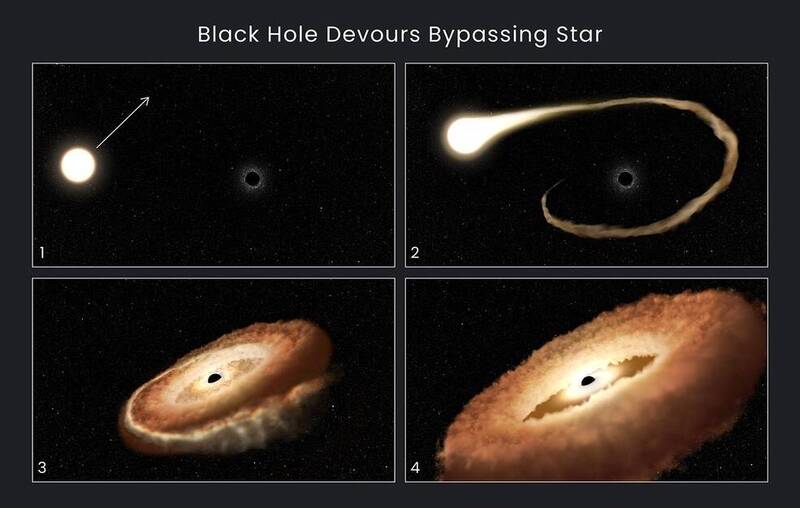This diagram depicts the four steps a black hole takes in a star.
(taken from NASA official website)
[Compiled Chen Chengliang/Comprehensive Report] When an unfortunate star hovers near a black hole, the latter's gravity will tear it violently and release intense radiation.
NASA's Hubble Space Telescope recently recorded in detail the final moments of a star being swallowed by a black hole.
The video released by NASA on the 12th shows that a hungry black hole twists the captured star into a donut shape and then swallows it. The picture is shocking.
Black holes devouring stars is the craziest and most tragic picture in the universe. This kind of cosmic scuffle scene is called "star tidal destruction event" (TDE), which only happens once every 10,000 to 100,000 years.
The Hubble Telescope uses spectroscopy to obtain a large amount of data and capture wonderful moments.
Please read on...
NASA says there's a balance between the black hole's gravity pulling in stellar stuff and the radiation blowing matter out.
Astronomers are using the Hubble Space Telescope to understand what happens when an unconstrained star falls into the gravitational "abyss" of a black hole.
Hubble was unable to photograph the chaos of the AT2022dsb tidal event up close because the engulfed star lies nearly 300 million light-years away in the core of the galaxy ESO 583-G004.
But astronomers have used Hubble's powerful ultraviolet sensitivity to study the light of shattered stars, which include hydrogen, carbon and more.
Correlation spectroscopy provides "forensic" clues to black hole engulfment.
NASA53 pointed out that the "Star Tidal Destruction Event" event stated that the feeding habits of black holes are "messy". The black hole's wind is projected toward Earth at about 3% the speed of light.
Analyzing AT2022dsb spectroscopic data collected by the Hubble Telescope, the team also determined that the star was ripped apart to form a disk of gas orbiting the black hole about the size of the solar system.
For astronomers, the "star tidal disruption event" scene is an exciting place, because it can reveal a lot about black holes.
News from #AAS241!
Hubble recorded a star's final moments as it was ripped apart and eaten up by a black hole – getting twisted into a donut-like shape in the process.
Find out more: https://t.co/CEGLVP2Nly pic .twitter.com/QUbdp6RpNa
— Hubble (@NASAHubble) January 12, 2023
